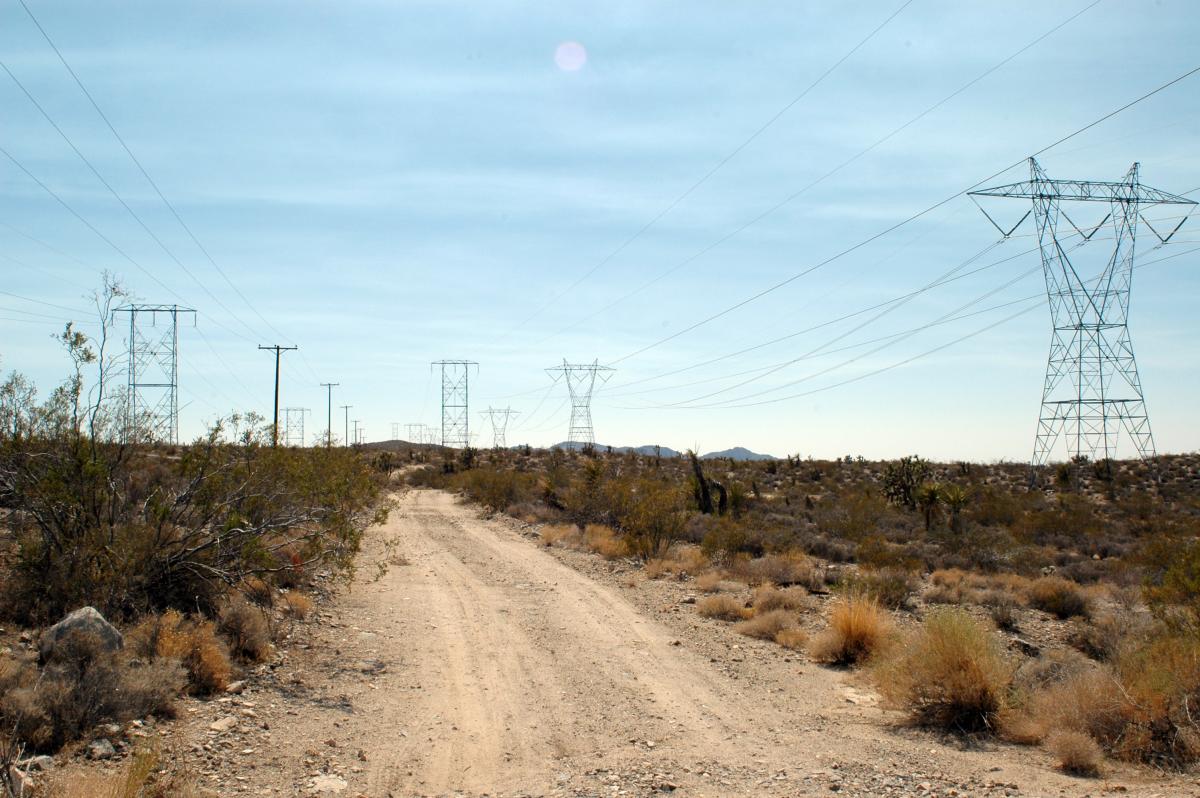Potential Major Corridor: The DesertXpress
The DesertXpress, a high-speed passenger train proposed to run between Victorville, California and Las Vegas, Nevada, represents a potentially major new linear corridor running through the California desert. The rail would generally run alongside I-15 and is meant to offer an alternative transportation option for Californians to access Las Vegas.1 Potential impacts of this proposed linear corridor include permanent removal of some special-status plants, loss of suitable desert tortoise (Gopherus agassizii) and Mohave ground squirrel (Spermophilus mohavensis) habitat, increased habitat fragmentation, and mortality of wildlife during construction phase.2
1 Department of Transportation, DesertXpress High-Speed Passenger Train: Draft Environmental Impact Statement and 4(F) Evaluation, 2009, prepared by USDOT Federal Railroad Administration, http://www.fra.dot.gov/us/content/1703.
2 Department of Transportation, DesertXpress High-Speed Passenger Train: Draft Environmental Impact Statement and 4(F) Evaluation, 2009, prepared by USDOT Federal Railroad Administration, http://www.fra.dot.gov/us/content/1703.
Linear Corridors

Linear corridors such as roads and vehicular routes, railways, pipelines, and powerlines create long, narrow corridors of disturbance that can affect land far beyond the actual area of the infrastructure (Figure 1). Direct impacts include destruction of soil and plant cover during construction, and prevention of recovery and revegetation of an area due to infrastructure operation and maintenance.1
The California desert contains a wide variety and abundance of vehicular routes, including OHV trails, unimproved and improved local roads, arterial roads, and limited-access highways.2 Vehicular routes can affect soils by disturbing soil crusts, changing water runoff patterns, and accelerating soil erosion rates, which affects plant productivity and composition through an alteration of water and nutrient flow across the landscape.3,4 These routes can also increase human access to natural areas, which can amplify other human-related disturbances such as illegal collection and vandalism of plants and animals.5,6 In addition, routes can increase air pollution, increase accumulation of pollutants (e.g. heavy metals) in soils and plants, facilitate non-native species invasion, and lead to wildlife mortality.7
1 J.E. Lovich and D. Bainbridge, “Anthropogenic Degradation of the Southern California Desert Ecosystem and Prospects for Natural Recovery and Restoration,” Environmental Management 24, no. 3 (1999): 309-326.
2 M.L. Brooks and B.M. Lair, “Ecological Effects of Vehicular Routes,” In The Mojave Desert: Ecosystem Processes and Sustainability, ed. R.H. Webb, L.F. Fenstermaker, J.S. Heaton, D.L. Hughson, E.V. McDonald, and D.M. Miller, (Reno: The University of Nevada Press, 2009), 168-195.
3 J.E. Lovich and D. Bainbridge, “Anthropogenic Degradation of the Southern California Desert Ecosystem and Prospects for Natural Recovery and Restoration,” Environmental Management 24, no. 3 (1999): 309-326.
4 M.L. Brooks and B.M. Lair, “Ecological Effects of Vehicular Routes,” In The Mojave Desert: Ecosystem Processes and Sustainability, ed. R.H. Webb, L.F. Fenstermaker, J.S. Heaton, D.L. Hughson, E.V. McDonald, and D.M. Miller, (Reno: The University of Nevada Press, 2009), 168-195.
5 J.E. Lovich and D. Bainbridge, “Anthropogenic Degradation of the Southern California Desert Ecosystem and Prospects for Natural Recovery and Restoration,” Environmental Management 24, no. 3 (1999): 309-326.
6 M.L. Brooks and B.M. Lair, “Ecological Effects of Vehicular Routes,” In The Mojave Desert: Ecosystem Processes and Sustainability, ed. R.H. Webb, L.F. Fenstermaker, J.S. Heaton, D.L. Hughson, E.V. McDonald, and D.M. Miller, (Reno: The University of Nevada Press, 2009), 168-195.
7 M.L. Brooks and B.M. Lair, “Ecological Effects of Vehicular Routes,” In The Mojave Desert: Ecosystem Processes and Sustainability, ed. R.H. Webb, L.F. Fenstermaker, J.S. Heaton, D.L. Hughson, E.V. McDonald, and D.M. Miller, (Reno: The University of Nevada Press, 2009), 168-195.
